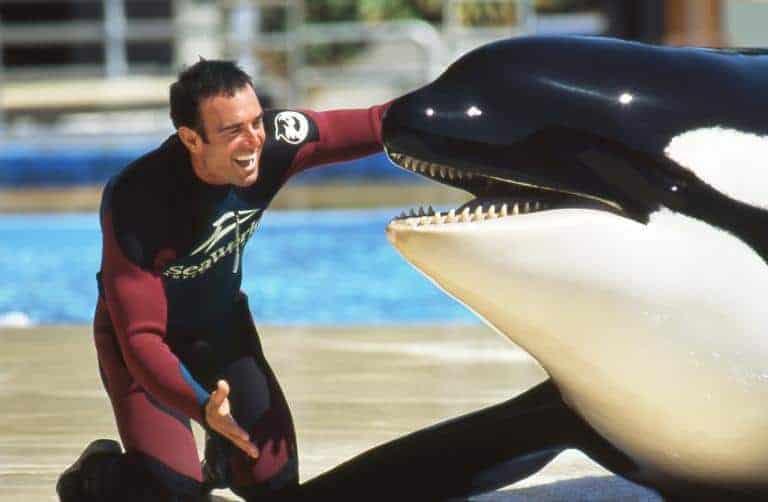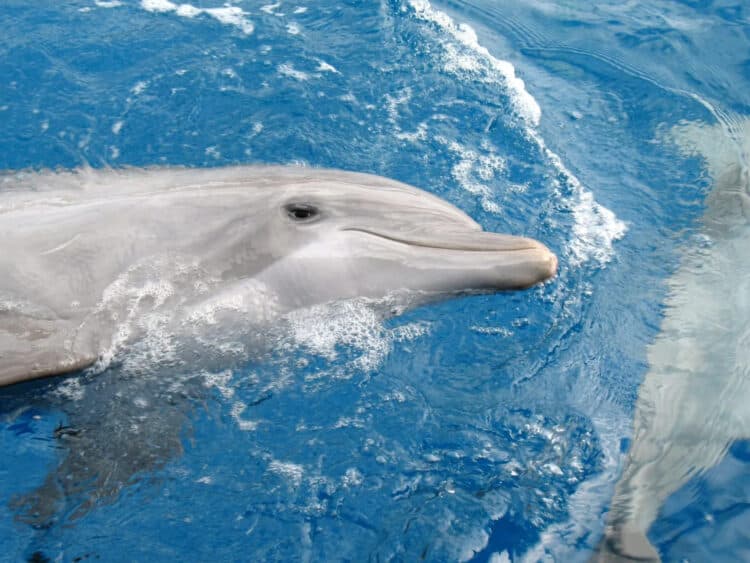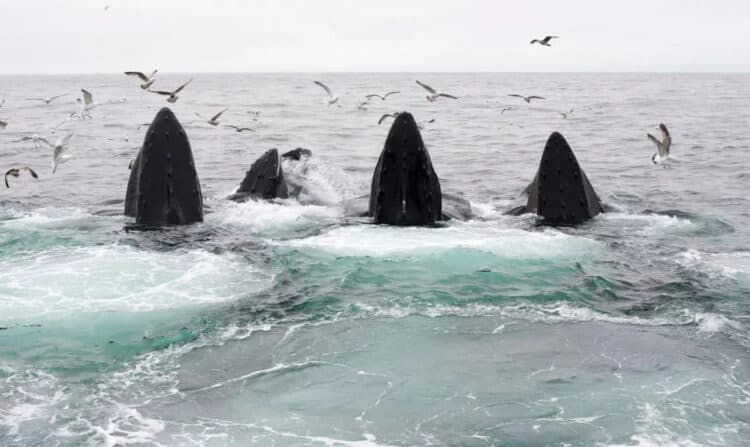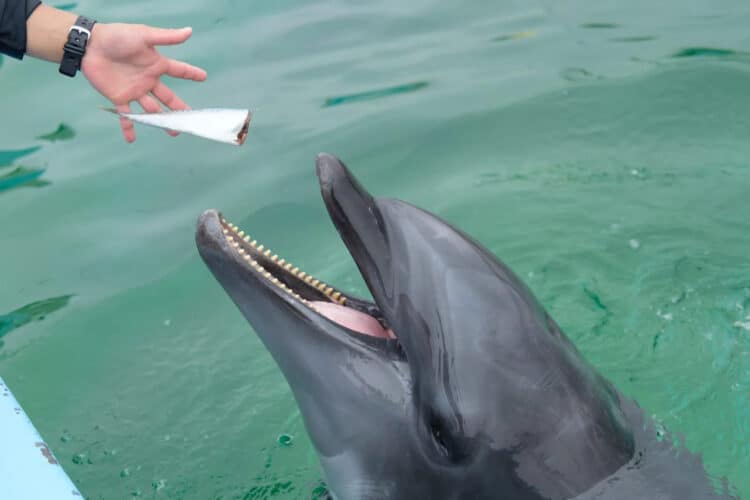In 2013, the movie Blackfish exposed the dark side of orca shows at the marine park franchise SeaWorld by documenting the deaths of several trainers. John Hargrove, author of Beneath the Surface: Killer Whales, SeaWorld, and the Truth Beyond Blackfish, was the senior trainer at the time and one of the most experienced orca handlers in the world. He has since left SeaWorld and is now an advocate for orcas.
Speaking from his home in New York, he describes how a childhood experience in Florida made him fall in love with orcas, why he marvels at and fears them, how captivity impoverishes and deforms their lives, and why he believes it is time to stop treating orcas like circus animals.
The book opens with a terrifying experience with an orca called Freya. Put us inside that moment. That was the first and only time in my career that I questioned whether I was going to make it out alive. In killer whale training you zip up that wet suit and believe in your relationship and your abilities.

The incident took place at a SeaWorld affiliate in France. Freya was the most dangerous of all the whales that did water work there.
That day I had been swimming with Freya’s son in another pool. She had been watching the whole interaction, as though she was enjoying it and wanted to participate.
So at one point during the play session with her son, I had her son throw me over into Freya’s pool, after I’d already established control with her through the gate. But she refused food that I had in my hand to reinforce her for coming over to me.
 She kept her mouth shut and then pushed me with her rostrum [snout] into my chest. I tried to deflect off of her. But the precision of these animals is amazing.
She kept her mouth shut and then pushed me with her rostrum [snout] into my chest. I tried to deflect off of her. But the precision of these animals is amazing.
You can’t get away, you can’t deflect. She maneuvered me into the middle of the pool, exactly where she wanted me: farthest from safety and other trainers.
I asked her for a behavior, but she refused. I asked for a different type of behavior, and she refused that. I then asked for an emergency recall, which means she should swim away to a designated spot to another trainer.
But she refused that too, and sank down to about three feet in front of me. She rolled sideways, looking at me under the water, so I could see her eye.
Then she opened her mouth. I knew what she was going to do. She was going to put me in her mouth…
How did you become an orca trainer? It’s not a usual career path.
[Laughs] It’s not. But I wanted to do it since I was six, when I first saw a Shamu show in Florida, in 1980. I remember being so seduced by the whole environment, like a kid who wants to be a magician at his first magic show. I could see the relationship between the trainers and the whales: this huge, impressive animal and this little bitty trainer in the water, with people in the stadium and the lights. It was just an overpowering experience for me. And from that day forward it was my identity. And still is.
You say that at the heart of your relationship with orcas were “wonderment and dread.” Explain those two polarities and how the death of Dawn Brancheau affected you.
The wonderment is how I felt as a child, and how I felt as an adult at SeaWorld for many years. The dread of it was that you knew at the end of the day that these were still killer whales: wild animals, apex predators, that can make that decision at any moment, as we tragically saw play out with Dawn and Tilikum.
We’ll never know why Tilikum made that choice to grab Dawn and pull her into the pool. He had a great relationship with her, and she had a great relationship with him. I do believe that he loved her, and I know that she loved him. But though SeaWorld denies it, this was a horrific, aggressive event. SeaWorld’s expert witness, Jeff Andrews, said that Tilikum was never aggressive with Dawn.
What’s so outrageous about that is that he didn’t just drown Dawn. He dismembered her. He tore off her left arm and scalped her. Her scalp and full head of hair were on the bottom of the pool. He severed her spinal cord.
And he never gave her body up. They had to forcibly take the body away from him. These are graphic details, but people have a right to know the true nature of what happened and not have it sugarcoated because it’s painful to hear. The judge recognized that, too, and stated it.

(A SeaWorld spokesman has denied that Tilikum’s killing of three trainers showed aggressive intent and has defended the star orca’s reentry into the performing world 13 months after Brancheau’s death, saying it “is an important component of his physical, social, and mental enrichment.”)
You had a favorite orca. Tell us about Takara, the “Princess of San Antonio,” and why you loved her so much.
I loved her mother, Kasatka, very much too, even though she was the most dangerous water work whale in the corporation. If you’ve seen Blackfish, she’s in the scene where she’s dragging Petey, the bald-headed guy, down to the bottom of the pool over and over again. But I had a great relationship with Kasatka.
Her daughter was exactly like her mother. I swam with her for many years, in day shows, in night shows. I had been injured with her, and felt her treat me with care during my injuries. I trusted her on a very high level. The greatest compliment I ever received was when a young trainer said, “That’s what I want.
One day I want to have a relationship with a killer whale as strong as John’s with Takara.” But I never lost sight of the fact that one day she could betray me, because at the end of the day she is a killer whale.
What are the negative physical and psychological effects of confinement and training on orcas?
I wish it wasn’t that way. It would make my life so much easier if I could say that those animals are thriving in captivity, living happy and enriched lives. Unfortunately, after all the years of experience that I had, I saw the psychological and physical trauma that results from captivity.
A massive corporate entity is exploiting the hell out of the whales and the trainers. You are nothing more than a number on a sheet, and if the moment arises, you will be thrown under the bus and even blamed for your own death.
(“We don’t put any animal in any stressful situation,” SeaWorld’s curator of zoological operations, Chuck Tompkins, has said.)
You say that the battle over SeaWorld’s orcas is “part of a larger debate on the ethics of humankind’s relationship with other inhabitants of this planet.” Explain.
I’m not a religious person. I’m spiritual but not religious. But I had this argument with a French friend, though I have lost her friendship now because of all of this. Her family was deeply religious. They were wonderful people, and I loved her very much and her whole family.
But she and I got into this debate after Blackfish came out. I asked her: “Do you really believe it’s acceptable that we rip these animals from their natural families in the wild, killing some of their family members in the process, then put them in concrete pools, for a corporation to make enormous profits and for people to be entertained?”
Her answer was: “Yes, because the Bible says we have dominion over all the animals.” It’s such arrogance! And though I’m not a theologian, I am confident that that’s not what this scripture means.
I interpret that scripture as meaning if we have dominion over all the animals, we are here to make sure something like that never happens. It’s shameful that as a species we are so arrogant to believe that we can do whatever we want to any animal.

You are now an advocate against SeaWorld. Have you been threatened with legal action?
SeaWorld started to threaten me with legal action back in November. Luckily, I have great attorneys at Macmillan. I also hired my own legal team because I know SeaWorld very well. They are bullies who for decades have silenced trainers who threatened to speak out. But I’m not going to be silenced. I have a right to speak about my life and my experiences, and I’m not going to let a corporation like SeaWorld try to shut me up. I live in America, and I have a First Amendment right. So I made sure I have the people on my team to protect those rights.
One of the problems facing SeaWorld is that, even if they wanted to, they cannot release their orcas into the wild, because many of them have been raised in captivity. What do you think their future should be?
It’s actually quite simple. First of all, they have to stop their breeding program. If you don’t stop your breeding program, you’re going to have killer whales in captivity till the end of time. But SeaWorld can’t release these whales into the wild anyway, because they’ve inbred them.
You have types of whales that would never interact naturally in the wild: hybrid killer whales that don’t exist in nature. There are also horrific health issues due to captivity. But I’ve spoken with some brilliant-minded people, and I believe sea sanctuaries are a viable solution.
They should follow the example of the Ringling Brothers, who recently acknowledged that their customers had shifted in their thinking about having elephants in captivity. So by 2018, all of Ringling Brothers’ elephants are going to be retired to elephant sanctuaries.
SeaWorld wants to make it sound like it’s impossible. But we’ve been doing sea pens or sea sanctuaries since the seventies. The U.S. Navy had an open-ocean killer whale in a sea pen years ago.
What would you say to a child who has the same dream you did of being an orca trainer?
That’s a really tough one. And I’ve thought about it a lot. First of all, I don’t have the right to tell a child what dream they can and can’t have. Nobody has that right. I would just encourage them to seek out all of the information, and to understand the damage that is happening to these animals so that you can be entertained and a global corporation can make hundreds of millions of dollars’ profit off of them every year. It is just morally and ethically unacceptable.
This article was first published by National Geographic on 29 Mar 2015.
We invite you to share your opinion whether whales and dolphins should be kept in captivity for our entertainment? Please vote and leave your comments at the bottom of this page:
Thank you for voting.
In the event that you have voted that whales and dolphins should not be held in captivity, please sign the petition:
Enact the Orca Welfare and Safety Act
Thank you for your support.






Leave a Reply